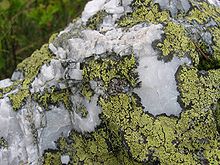| Rhizocarpon geographicum | |
|---|---|

| |
| Scientific classification | |
| Domain: | Eukaryota |
| Kingdom: | Fungi |
| Division: | Ascomycota |
| Class: | Lecanoromycetes |
| Order: | Rhizocarpales |
| Family: | Rhizocarpaceae |
| Genus: | Rhizocarpon |
| Species: | R. geographicum |
| Binomial name | |
| Rhizocarpon geographicum (L.) DC. | |
Rhizocarpon geographicum (the map lichen) is a species of lichen, which grows on rocks in mountainous areas of low air pollution. Each lichen is a flat patch bordered by a black line of fungal hyphae. These patches grow adjacent to each other, leading to the appearance of a map or a patchwork field.
When circular, or roughly circular, the diameter of this lichen species has been widely used to help determining the relative age of deposits, e.g. moraine systems, thus revealing evidence of glacial advances. The process is termed lichenometry. This technique is generally attributed to the work of Roland Beschel in the Alps.
Lichenometry is based on the assumption that the largest lichen growing on a rock is the oldest individual. Generally, the five largest lichen thalli diameters are taken, although several statistical methods have been used. If the growth rate is known, the maximum lichen size will give a minimum age for when this rock was deposited. The growth rate curve, a graph of age of a lichen against the date of the substrate on which it is found has to be constructed for an area. Beschel originally used gravestones to produce a calibration curve. Growth rates for different areas and species can be obtained by measuring maximum lichen sizes on substrates of known age, such as gravestones, historic or prehistoric rock buildings, or moraines of known age (e.g. those deposited during the Little Ice Age).
Distribution
This lichen species is broadly distributed and may be found in most cold areas with exposed rock surfaces. The North American range includes the Sierra Nevada and northern Boreal forests of Canada, Greenland, Iceland, Fennoscandia and Siberia. In the tropics it only occurs at high altitudes such as the Andes of Peru and Colombia. Further south the map lichen is found broadly across Patagonia, in the Falkland Islands, the sub Antarctic islands and the Antarctic Peninsula.
In Britain it can be found commonly growing on hard siliceous rocks, especially in upland regions. Its range covers virtually all of Scotland, much of North West England, and other upland areas in much of the rest of England, Wales and Ireland too.
In Spain it is found primarily in siliceous mountain ranges, although occasionally it can be found near sea level, even in southern Spain, where it is known from Cabo de Gata.

Ecology
Rhizocarpon geographicum is a known host to the lichenicolous fungus species Muellerella pygmaea.
Life span
One specimen of Rhizocarpon geographicum on East Baffin Island has an estimated age of 9500 years. Thalli of Rhizocarpon geographicum in the central Brooks Range of northern Alaska have been given a maximum possible age of 10,000–11,500 years.
Outer space
In an experiment, this lichen species was placed in a capsule and launched into space. The capsule was opened, exposing the lichen to space conditions for 10 days before being brought back down to Earth, where it showed minimal changes or damage.
Further information: BIOPAN and EXPOSESee also
References
- Beschel, R. E. 1950. Flechten als Altersmaßstab rezenter Moränen.Zeitschrift für Gletscherkunde und Glazialgeologie NF, 1:151-62. (Translated by W. Barr as Lichens as a measure of the age of recent moraines. Arctic and Alpine Research, 5, 303-309)
- Tracy Irwin Storer, Robert Leslie Usinger and David Lukas. 2004. Sierra Nevada Natural History, 2nd ed, University of California Press, ISBN 0-520-24096-0, ISBN 978-0-520-24096-4, 439 pages
- C. Michael Hogan. (2008) Black Spruce: Picea mariana, GlobalTwitcher.com, ed. Nicklas Stromberg Archived 2011-10-05 at the Wayback Machine
- Garibotti, Irene A.; Pissolito, Clara I.; Villalba, Ricardo (February 2011). "Vegetation Development on Deglaciated Rock Outcrops from Glaciar Frías, Argentina". Arctic, Antarctic, and Alpine Research. 43 (1): 35–45. doi:10.1657/1938-4246-43.1.35. JSTOR 41240397. S2CID 53123208.
- Sancho, Leopoldo G.; Palacios, David; Green, T. G. Allan; Vivas, Mercedes; Pintado, Ana (2011). "Extreme high lichen growth rates detected in recently deglaciated areas in Tierra del Fuego". Polar Biology. 34 (6): 813––822. doi:10.1007/s00300-010-0935-4. S2CID 35963180.
- Global Biodiversity Information Facility Archived 2016-03-03 at the Wayback Machine
- Frank Dobson. 1979. Lichens, An Illustrated Guide The Richmond Publishing Co Ltd, ISBN 0-85546-203-5, page 244
- Burgaz, A. R. (2014). "Líquenes de Andalucía (S de España): catálogo bibliográfico y nuevos datos del NW del área". Botanica Complutensis. 38: 53–88. doi:10.5209/rev_BOCM.2014.v38.45775.
- Svane, Svanhildur Jónsdóttir; Alstrup, Vagn (2004). "Some lichenicolous fungi from Iceland" (PDF). Acta Botanica Islandica. 14: 53–58.
- Rosenwinkel, Swenja; Korup, Oliver; Landgraf, Angela; Dzhumabaeva, Atyrgul (2015). "Limits to lichenometry". Quaternary Science Reviews. 129: 229–238. doi:10.1016/j.quascirev.2015.10.031.
- Miller, G. H.; Andrews, J. T. (April 1972). "Quaternary History of Northern Cumberland Peninsula, East Baffin Island, N.W.T., Canada Part VI: Preliminary Lichen Growth Curve for Rhizocarpon geographicum". GSA Bulletin. 83 (4): 1133–1138. doi:10.1130/0016-7606(1972)83[1133:QHONCP]2.0.CO;2.
- Haworth, Leah A.; Calkin, Parker E.; Ellis, James M. (1986). "Direct Measurement of Lichen Growth in the Central Brooks Range, Alaska, U.S.A., and Its Application to Lichenometric Dating, Arctic and Alpine Research". Arctic and Alpine Research. 18 (3): 289–296. doi:10.2307/1550886.
- Benedict, James B. (January 2009). "A Review of Lichenometric Dating and Its Applications to Archaeology". American Antiquity. 74 (1): 143–172. doi:10.1017/S0002731600047545.
- de la Torre, Rosa; Leopoldo G. Sancho; Gerda Horneck; Asunción de los Ríos; Jacek Wierzchos; Karen Olsson-Francis; Charles S. Cockell; Petra Rettberg; Thomas Berger; Jean-Pierre P. de Vera (August 2010). "Survival of lichens and bacteria exposed to outer space conditions – Results of the Lithopanspermia experiments". Icarus. 208 (2): 735–748. Bibcode:2010Icar..208..735D. doi:10.1016/j.icarus.2010.03.010. ISSN 0019-1035.
 Media related to Rhizocarpon geographicum at Wikimedia Commons
Media related to Rhizocarpon geographicum at Wikimedia Commons
| Taxon identifiers | |
|---|---|
| Rhizocarpon geographicum |
|
| Lichen geographicus | |